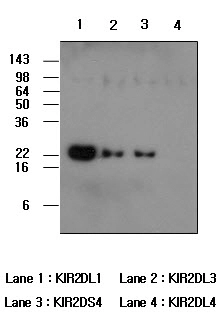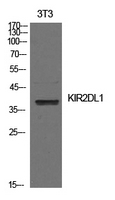
Recombinant human protein kIR2DL1, kIR2DL3, kIR2DS4 and kIR2DL4 (each 50ng per well) were resolved by SDS-PAGE, transferred to PVDF membrane and probed with anti-human kIR2DL1 (1:500). Proteins were visualized using a goat anti-mouse secondary antibody co
KIR2DL1 antibody [2F9]
GTX50065
ApplicationsImmunoPrecipitation, Western Blot, ELISA
Product group Antibodies
TargetKIR2DL1
Overview
- SupplierGeneTex
- Product NameKIR2DL1 antibody [2F9]
- Delivery Days Customer9
- Application Supplier NoteWe recommend the following starting dilutions:Western Blot: Use at 1:500 ~ 2,000.Optimal working concentrations should be determined experimentally by the end user.
- ApplicationsImmunoPrecipitation, Western Blot, ELISA
- CertificationResearch Use Only
- ClonalityMonoclonal
- Clone ID2F9
- Concentration1 mg/ml
- ConjugateUnconjugated
- Gene ID3802
- Target nameKIR2DL1
- Target descriptionkiller cell immunoglobulin like receptor, two Ig domains and long cytoplasmic tail 1
- Target synonymsCD158A, KIR-K64, KIR221, KIR2DL3, NKAT, NKAT-1, NKAT1, p58.1, killer cell immunoglobulin-like receptor 2DL1, CD158 antigen-like family member A, KIR2DL protein, KIR2DL1/3DL2, MHC class I NK cell receptor, killer cell immunoglobulin-like receptor, two domains, long cytoplasmic tail, 1, killer inhibitory receptor 2-2-1, natural killer-associated transcript 1, p58 NK cell inhibitory receptor NKR-K6, p58 NK receptor CL-42/47.11, p58 killer cell inhibitory receptor KIR-K64, p58 natural killer cell receptor clones CL-42/47.11, p58.1 MHC class-I-specific NK receptor
- HostMouse
- IsotypeIgG2a
- Protein IDP43626
- Protein NameKiller cell immunoglobulin-like receptor 2DL1
- Scientific DescriptionKiller cell immunoglobulin-like receptors (KIRs) are transmembrane glycoproteins expressed by natural killer cells and subsets of T cells. The KIR genes are polymorphic and highly homologous and they are found in a cluster on chromosome 19q13.4 within the 1 Mb leukocyte receptor complex (LRC). The gene content of the KIR gene cluster varies among haplotypes, although several framework genes are found in all haplotypes (KIR3DL3, KIR3DP1, KIR3DL4, KIR3DL2). The KIR proteins are classified by the number of extracellular immunoglobulin domains (2D or 3D) and by whether they have a long (L) or short (S) cytoplasmic domain. KIR proteins with the long cytoplasmic domain transduce inhibitory signals upon ligand binding via an immune tyrosine-based inhibitory motif (ITIM), while KIR proteins with the short cytoplasmic domain lack the ITIM motif and instead associate with the TYRO protein tyrosine kinase binding protein to transduce activating signals. The ligands for several KIR proteins are subsets of HLA class I molecules; thus, KIR proteins are thought to play an important role in regulation of the immune response. [provided by RefSeq, Jul 2008]
- Storage Instruction-20°C or -80°C,2°C to 8°C
- UNSPSC12352203





